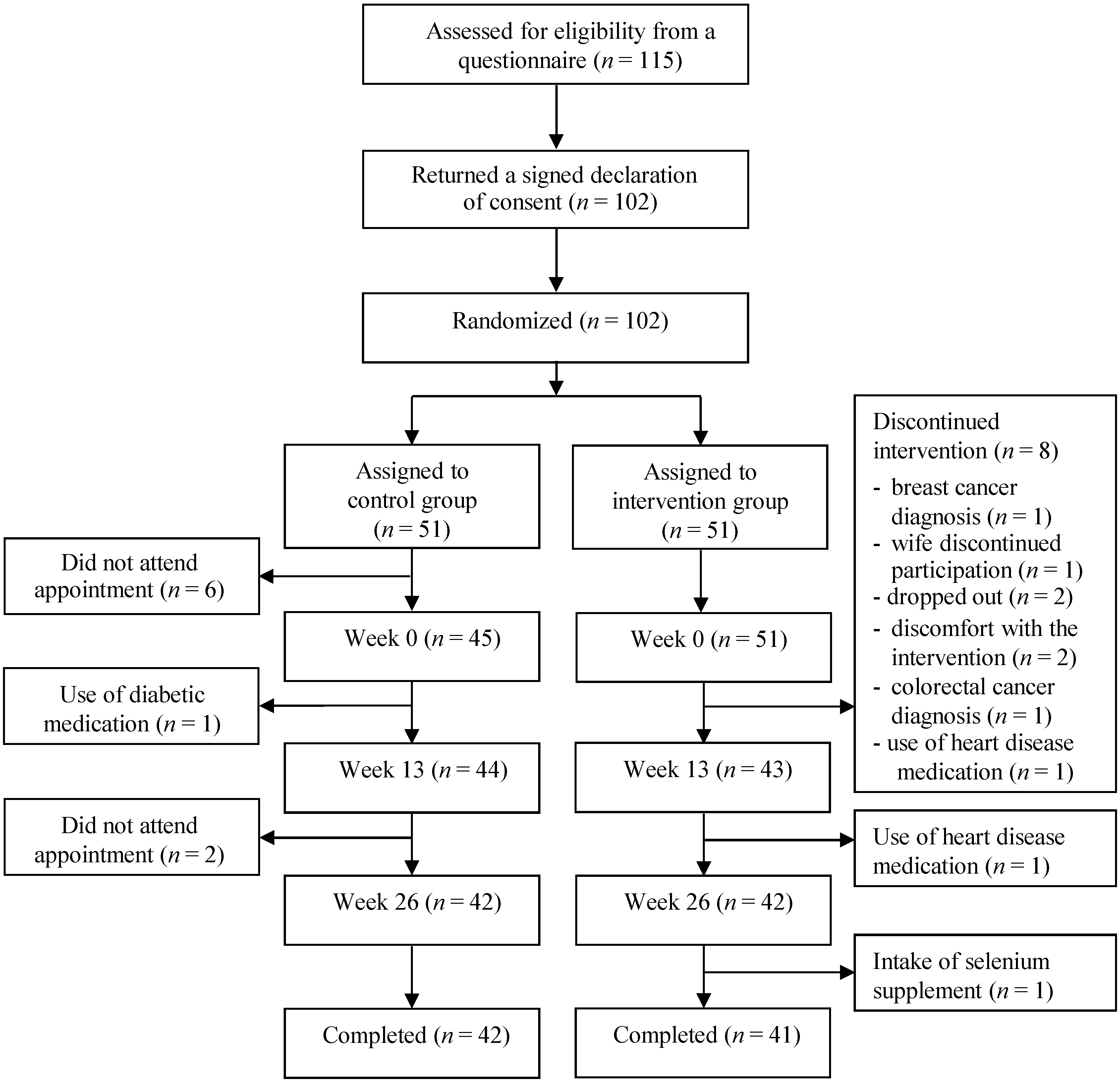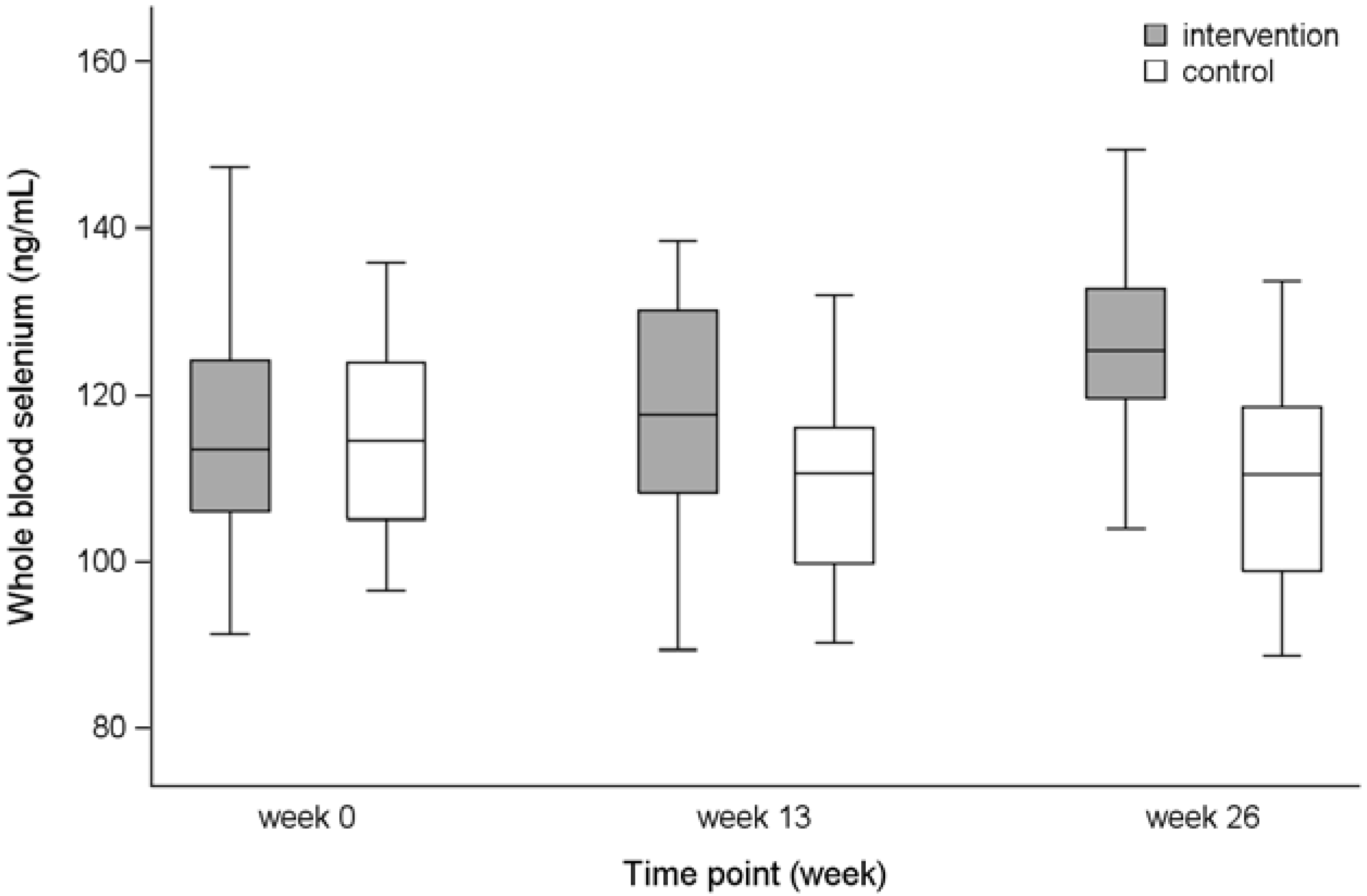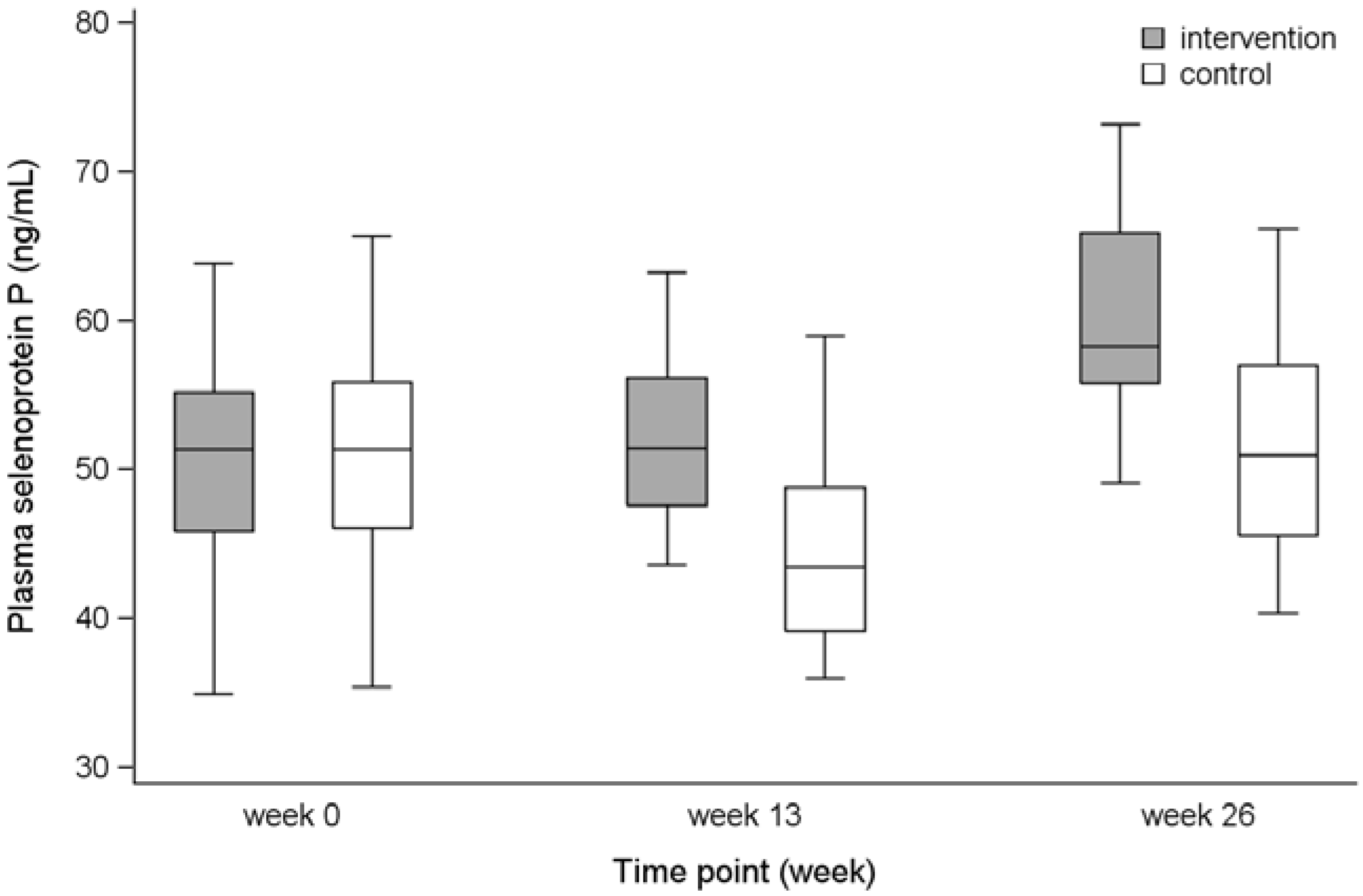The Effect on Selenium Concentrations of a Randomized Intervention with Fish and Mussels in a Population with Relatively Low Habitual Dietary Selenium Intake
Abstract
:1. Introduction
2. Methods
2.1. Study Design
2.2. Study Population
2.3. Dietary Intervention
2.4. Control Group
2.5. Data Collection
2.6. Power Analysis
2.7. Randomization
2.8. Blinding
2.9. Chemical Analyses
2.10. Statistical Methods
3. Results
3.1. Study Participants
3.2. Baseline Characteristics
3.3. Compliance
3.4. Whole Blood Selenium

| Variable | Intervention (n = 49) | Control (n = 45) |
|---|---|---|
| Women | 21 (43%) | 19 (42%) |
| Men | 28 (57%) | 26 (58%) |
| Age, year | 61 (51–72) | 59 (51–73) |
| BMI, kg/m2 | 26.3 (21.0–31.1) | 25.2 (20.3–32.5) |
| Whole blood selenium, ng/mL | 113.5 (91.3–147.4) | 114.6 (96.6–136.0) 1 |
| Plasma selenoprotein P, ng selenium/mL | 51.4 (35.0–64.0) 2 | 51.4 (35.4–65.7) 3 |
| Plasma selenium, ng/mL | 84.7 (67.8–106.5) 2 | 86.4 (70.5–103.3) 3 |
| Mean Change within Group (95% CI) | Difference between Group Mean Change (95% CI) | |||||
|---|---|---|---|---|---|---|
| n | Weeks 0–13 | n | Weeks 0–26 | n | Weeks 0–26 | |
| Whole blood selenium, ng/mL | ||||||
| Intervention | 41 | 2.0 (−1.3, 5.2) | 41 | 10.8 (7.4, 14.2) | 82 | 14.9 (10.2, 19.7) |
| Control | 43 | −5.3 (−8.5, −2.1) | 41 | −4.1 (−7.5, −0.7) | ||
| Plasma selenoprotein P, ng selenium/mL | ||||||
| Intervention | 37 | 1.9 (−1.2, 5.1) | 38 | 10.2 (7.4, 13.0) | 78 | 7.0 (3.1, 10.9) |
| Control | 42 | −5.6 (−8.5, −2.6) | 40 | 3.2 (0.5, 5.9) | ||

| Mean Change within Group (95% CI) | P Interaction | |||||
|---|---|---|---|---|---|---|
| n | Weeks 0–13 | n | Weeks 0–26 | Weeks 0–13 | Weeks 0–26 | |
| Intake of dietary selenium supplement | 0.06 | 0.08 | ||||
| Intervention | 19 | −2.9 (−7.6, 1.7) | 19 | 8.4 (3.5, 13.3) | ||
| Control | 18 | −5.6 (−10.4, −0.9) | 18 | −1.9 (−6.9, 3.2) | ||
| No intake of dietary selenium supplement | ||||||
| Intervention | 22 | 6.2 (1.9, 10.5) | 22 | 12.9 (8.3, 17.5) | ||
| Control | 25 | −5.1 (−9.1, −1.0) | 23 | −5.9 (−10.4, −1.4) | ||
3.5. Plasma SelP

4. Discussion
5. Conclusions
Acknowledgments
Author Contributions
Conflicts of Interest
References
- Fairweather-Tait, S.J.; Bao, Y.; Broadley, M.R.; Collings, R.; Ford, D.; Hesketh, J.E.; Hurst, R. Selenium in human health and disease. Antioxid. Redox Signal. 2011, 14, 1337–1383. [Google Scholar] [CrossRef] [PubMed]
- Rayman, M.P. Selenium and human health. Lancet 2012, 379, 1256–1268. [Google Scholar] [CrossRef] [PubMed]
- Burk, R.F.; Hill, K.E. Selenoprotein P: An extracellular protein with unique physical characteristics and a role in selenium homeostasis. Annu. Rev. Nutr. 2005, 25, 215–235. [Google Scholar] [CrossRef] [PubMed]
- Moschos, M.P. Selenoprotein P. Cell. Mol. Life Sci. 2000, 57, 1836–1845. [Google Scholar] [CrossRef] [PubMed]
- Hurst, R.; Armah, C.N.; Dainty, J.R.; Hart, D.J.; Teucher, B.; Goldson, A.J.; Broadley, M.R.; Motley, A.K.; Fairweather-Tait, S.J. Establishing optimal selenium status: Results of a randomized, double-blind, placebo-controlled trial. Am. J. Clin. Nutr. 2010, 91, 923–931. [Google Scholar] [CrossRef] [PubMed]
- Vinceti, M.; Dennert, G.; Crespi, C.M.; Zwahlen, M.; Brinkman, M.; Zeegers, M.P.; Horneber, M.; D’Amico, R.; Del, G.C. Selenium for preventing cancer. Cochrane Database Syst. Rev. 2014, 3, CD005195. [Google Scholar] [PubMed]
- Ravn-Haren, G.; Krath, B.N.; Overvad, K.; Cold, S.; Moesgaard, S.; Larsen, E.H.; Dragsted, L.O. Effect of long-term selenium yeast intervention on activity and gene expression of antioxidant and xenobiotic metabolising enzymes in healthy elderly volunteers from the Danish Prevention of Cancer by Intervention by Selenium (PRECISE) pilot study. Br. J. Nutr. 2008, 99, 1190–1198. [Google Scholar] [PubMed]
- Rasmussen, L.B.; Hollenbach, B.; Laurberg, P.; Carle, A.; Hog, A.; Jorgensen, T.; Vejbjerg, P.; Ovesen, L.; Schomburg, L. Serum selenium and selenoprotein P status in adult Danes—8-year followup. J. Trace Elem. Med. Biol. 2009, 23, 265–271. [Google Scholar] [CrossRef] [PubMed]
- Rayman, M.P. The argument for increasing selenium intake. Proc. Nutr. Soc. 2002, 61, 203–215. [Google Scholar] [CrossRef] [PubMed]
- Combs, G.F., Jr. Selenium in global food systems. Br. J. Nutr. 2001, 85, 517–547. [Google Scholar] [CrossRef] [PubMed]
- Brown, K.M.; Arthur, J.R. Selenium, selenoproteins and human health: A review. Public Health Nutr. 2001, 4, 593–599. [Google Scholar] [CrossRef] [PubMed]
- Rayman, M.P. Food-chain selenium and human health: Emphasis on intake. Br. J. Nutr. 2008, 100, 254–268. [Google Scholar] [PubMed]
- Alfthan, G.; Eurola, M.; Ekholm, P.; Venalainen, E.R.; Root, T.; Korkalainen, K.; Hartikainen, H.; Salminen, P.; Hietaniemi, V.; Aspila, P.; et al. Effects of nationwide addition of selenium to fertilizers on foods, and animal and human health in Finland: From deficiency to optimal selenium status of the population. J. Trace Elem. Med. Biol. 2014. [Google Scholar] [CrossRef]
- Fox, T.E.; van den Heuvel, E.G.; Atherton, C.A.; Dainty, J.R.; Lewis, D.J.; Langford, N.J.; Crews, H.M.; Luten, J.B.; Lorentzen, M.; Sieling, F.W.; et al. Bioavailability of selenium from fish, yeast and selenate: A comparative study in humans using stable isotopes. Eur. J. Clin. Nutr. 2004, 58, 343–349. [Google Scholar] [CrossRef] [PubMed]
- Fox, T.E.; Atherton, C.; Dainty, J.R.; Lewis, D.J.; Langford, N.J.; Baxter, M.J.; Crews, H.M.; Fairweather-Tait, S.J. Absorption of selenium from wheat, garlic, and cod intrinsically labeled with Se-77 and Se-82 stable isotopes. Int. J. Vitam. Nutr. Res. 2005, 75, 179–186. [Google Scholar] [CrossRef] [PubMed]
- Robinson, M.F.; Rea, H.M.; Friend, G.M.; Stewart, R.D.; Snow, P.C.; Thomson, C.D. On supplementing the selenium intake of New Zealanders. 2. Prolonged metabolic experiments with daily supplements of selenomethionine, selenite and fish. Br. J. Nutr. 1978, 39, 589–600. [Google Scholar] [CrossRef] [PubMed]
- Meltzer, H.M.; Bibow, K.; Paulsen, I.T.; Mundal, H.H.; Norheim, G.; Holm, H. Different bioavailability in humans of wheat and fish selenium as measured by blood platelet response to increased dietary Se. Biol. Trace Elem. Res. 1993, 36, 229–241. [Google Scholar] [CrossRef]
- Saxholt, E.; Christensen, A.T.; Møller, A.; Hartkopp, H.B.; Ygil, K.H.; Hels, O.H. Danish Food Composition Databank, Revision 7; Department of Nutrition, National Food Institute, Technical University of Denmark: Lyngby, Denmark, 1 December 2008. Available online: http://www.foodcomp.dk/v7/fvdb_search.asp (accessed on 1 December 2014).
- Greenwald, P.; Anderson, D.; Nelson, S.A.; Taylor, P.R. Clinical trials of vitamin and mineral supplements for cancer prevention. Am. J. Clin. Nutr. 2007, 85, 314S–317S. [Google Scholar] [PubMed]
- Pedersen, A.; Fagt, S.; Groth, M.; Christensen, T.; Biltoft-Jensen, A.; Matthiessen, J.; Andersen, N.; Kørup, K.; Hartkopp, H.; Ygil, K.; et al. Dietary Habits in Denmark, 2003–2008; Department of Nutrition, National Food Institute, Technical University of Denmark: Lyngby, Denmark, 2010. Available online: http://www.foedevarestyrelsen.dk/SiteCollectionDocuments/25_PDF_word_filer%20til%20download/07kontor/DanskernesKostvaner2010.pdf (accessed on 1 December 2013).
- Stonehouse, W.; Pauga, M.R.; Kruger, R.; Thomson, C.D.; Wong, M.; Kruger, M.C. Consumption of salmon v. salmon oil capsules: Effects on n-3 PUFA and selenium status. Br. J. Nutr. 2011, 106, 1231–1239. [Google Scholar] [CrossRef] [PubMed]
- Robinson, M.F.; Thomson, C.D.; Jenkinson, C.P.; Luzhen, G.; Whanger, P.D. Long-term supplementation with selenate and selenomethionine: Urinary excretion by New Zealand women. Br. J. Nutr. 1997, 77, 551–563. [Google Scholar] [CrossRef] [PubMed]
- Nunes, J.A.; Batista, B.L.; Rodrigues, J.L.; Caldas, N.M.; Neto, J.A.; Barbosa, F., Jr. A simple method based on ICP-MS for estimation of background levels of arsenic, cadmium, copper, manganese, nickel, lead, and selenium in blood of the Brazilian population. J. Toxicol. Environ. Health 2010, 73, 878–887. [Google Scholar] [CrossRef]
- Loeschner, K.; Hadrup, N.; Hansen, M.; Pereira, S.A.; Gammelgaard, B.; Moller, L.H.; Mortensen, A.; Lam, H.R.; Larsen, E.H. Absorption, distribution, metabolism and excretion of selenium following oral administration of elemental selenium nanoparticles or selenite in rats. Metallomics 2014, 6, 330–337. [Google Scholar] [CrossRef] [PubMed]
- Bugel, S.; Larsen, E.H.; Sloth, J.J.; Flytlie, K.; Overvad, K.; Steenberg, L.C.; Moesgaard, S. Absorption, excretion, and retention of selenium from a high selenium yeast in men with a high intake of selenium. Food Nutr. Res. 2008. [Google Scholar] [CrossRef]
- Ashton, K.; Hooper, L.; Harvey, L.J.; Hurst, R.; Casgrain, A.; Fairweather-Tait, S.J. Methods of assessment of selenium status in humans: A systematic review. Am. J. Clin. Nutr. 2009, 89, 2025S–2039S. [Google Scholar] [CrossRef] [PubMed]
- Longnecker, M.P.; Stram, D.O.; Taylor, P.R.; Levander, O.A.; Howe, M.; Veillon, C.; McAdam, P.A.; Patterson, K.Y.; Holden, J.M.; Morris, J.S.; et al. Use of selenium concentration in whole blood, serum, toenails, or urine as a surrogate measure of selenium intake. Epidemiology 1996, 7, 384–390. [Google Scholar] [CrossRef] [PubMed]
- Xia, Y.; Hill, K.E.; Li, P.; Xu, J.; Zhou, D.; Motley, A.K.; Wang, L.; Byrne, D.W.; Burk, R.F. Optimization of selenoprotein P and other plasma selenium biomarkers for the assessment of the selenium nutritional requirement: A placebo-controlled, double-blind study of selenomethionine supplementation in selenium-deficient Chinese subjects. Am. J. Clin. Nutr. 2010, 92, 525–531. [Google Scholar] [CrossRef] [PubMed]
- Thomson, C.D.; Robinson, M.F.; Butler, J.A.; Whanger, P.D. Long-term supplementation with selenate and selenomethionine: Selenium and glutathione peroxidase (EC 1.11.1.9) in blood components of New Zealand women. Br. J. Nutr. 1993, 69, 577–588. [Google Scholar] [CrossRef] [PubMed]
- Clausen, J.; Nielsen, S.A. Comparison of whole blood selenium values and erythrocyte glutathione peroxidase activities of normal individuals on supplementation with selenate, selenite, l-selenomethionine, and high selenium yeast. Biol. Trace Elem. Res. 1988, 15, 125–138. [Google Scholar] [CrossRef] [PubMed]
- Larsen, E.H.; Hansen, M.; Paulin, H.; Moesgaard, S.; Reid, M.; Rayman, M. Speciation and bioavailability of selenium in yeast-based intervention agents used in cancer chemoprevention studies. J. AOAC Int. 2004, 87, 225–232. [Google Scholar] [PubMed]
- Lassen, K.O.; Horder, M. Selenium status and the effect of organic and inorganic selenium supplementation in a group of elderly people in Denmark. Scand. J. Clin. Lab. Investig. 1994, 54, 585–590. [Google Scholar] [CrossRef]
- Papp, L.V.; Lu, J.; Holmgren, A.; Khanna, K.K. From selenium to selenoproteins: Synthesis, identity, and their role in human health. Antioxid. Redox Signal. 2007, 9, 775–806. [Google Scholar] [CrossRef] [PubMed]
- Moreda-Pineiro, J.; Moreda-Pineiro, A.; Romaris-Hortas, V.; Dominguez-Gonzalez, R.; Alonso-Rodriguez, E.; Lopez-Mahia, P.; Muniategui-Lorenzo, S.; Prada-Rodriguez, D.; Bermejo-Barrera, P. In vitro bioavailability of total selenium and selenium species from seafood. Food Chem. 2013, 139, 872–877. [Google Scholar] [CrossRef] [PubMed]
- Rayman, M.P. The importance of selenium to human health. Lancet 2000, 356, 233–241. [Google Scholar] [CrossRef] [PubMed]
- Mozaffarian, D. Fish, mercury, selenium and cardiovascular risk: Current evidence and unanswered questions. Int. J. Environ. Res. Public Health 2009, 6, 1894–1916. [Google Scholar] [CrossRef] [PubMed]
- Calatayud, M.; Devesa, V.; Virseda, J.R.; Barbera, R.; Montoro, R.; Velez, D. Mercury and selenium in fish and shellfish: Occurrence, bioaccessibility and uptake by Caco-2 cells. Food Chem. Toxicol. 2012, 50, 2696–2702. [Google Scholar] [CrossRef] [PubMed]
- Bates, C.J.; Thane, C.W.; Prentice, A.; Delves, H.T. Selenium status and its correlates in a British national diet and nutrition survey: People aged 65 years and over. J. Trace Elem. Med. Biol. 2002, 16, 1–8. [Google Scholar] [CrossRef] [PubMed]
- Thorling, E.B.; Overvad, K.; Heerfordt, A.; Foldspang, A. Serum Selenium in Danish Blood Bank Donors. Biol. Trace Elem. Res. 1985, 8, 65–73. [Google Scholar] [CrossRef] [PubMed]
- Swanson, C.A.; Longnecker, M.P.; Veillon, C.; Howe, M.; Levander, O.A.; Taylor, P.R.; McAdam, P.A.; Brown, C.C.; Stampfer, M.J.; Willett, W.C. Selenium intake, age, gender, and smoking in relation to indices of selenium status of adults residing in a seleniferous area. Am. J. Clin. Nutr. 1990, 52, 858–862. [Google Scholar] [PubMed]
- Garcia, M.J.; Alegria, A.; Barbera, R.; Farre, R.; Lagarda, M.J. Selenium, copper, and zinc indices of nutritional status: Influence of sex and season on reference values. Biol. Trace Elem. Res. 2000, 73, 77–83. [Google Scholar] [CrossRef] [PubMed]
- Persson-Moschos, M.E.; Stavenow, L.; Akesson, B.; Lindgarde, F. Selenoprotein P in plasma in relation to cancer morbidity in middle-aged Swedish men. Nutr. Cancer 2000, 36, 19–26. [Google Scholar] [CrossRef] [PubMed]
- Rayman, M.P. Selenoproteins and human health: Insights from epidemiological data. Biochim. Biophys. Acta 2009, 1790, 1533–1540. [Google Scholar] [CrossRef] [PubMed]
- Meplan, C.; Crosley, L.K.; Nicol, F.; Beckett, G.J.; Howie, A.F.; Hill, K.E.; Horgan, G.; Mathers, J.C.; Arthur, J.R.; Hesketh, J.E. Genetic polymorphisms in the human selenoprotein P gene determine the response of selenoprotein markers to selenium supplementation in a gender-specific manner (the SELGEN study). FASEB J. 2007, 21, 3063–3074. [Google Scholar] [CrossRef] [PubMed]
© 2015 by the authors; licensee MDPI, Basel, Switzerland. This article is an open access article distributed under the terms and conditions of the Creative Commons Attribution license (http://creativecommons.org/licenses/by/4.0/).
Share and Cite
Outzen, M.; Tjønneland, A.; Larsen, E.H.; Andersen, K.K.; Christensen, J.; Overvad, K.; Olsen, A. The Effect on Selenium Concentrations of a Randomized Intervention with Fish and Mussels in a Population with Relatively Low Habitual Dietary Selenium Intake. Nutrients 2015, 7, 608-624. https://doi.org/10.3390/nu7010608
Outzen M, Tjønneland A, Larsen EH, Andersen KK, Christensen J, Overvad K, Olsen A. The Effect on Selenium Concentrations of a Randomized Intervention with Fish and Mussels in a Population with Relatively Low Habitual Dietary Selenium Intake. Nutrients. 2015; 7(1):608-624. https://doi.org/10.3390/nu7010608
Chicago/Turabian StyleOutzen, Malene, Anne Tjønneland, Erik H. Larsen, Klaus K. Andersen, Jane Christensen, Kim Overvad, and Anja Olsen. 2015. "The Effect on Selenium Concentrations of a Randomized Intervention with Fish and Mussels in a Population with Relatively Low Habitual Dietary Selenium Intake" Nutrients 7, no. 1: 608-624. https://doi.org/10.3390/nu7010608
APA StyleOutzen, M., Tjønneland, A., Larsen, E. H., Andersen, K. K., Christensen, J., Overvad, K., & Olsen, A. (2015). The Effect on Selenium Concentrations of a Randomized Intervention with Fish and Mussels in a Population with Relatively Low Habitual Dietary Selenium Intake. Nutrients, 7(1), 608-624. https://doi.org/10.3390/nu7010608





